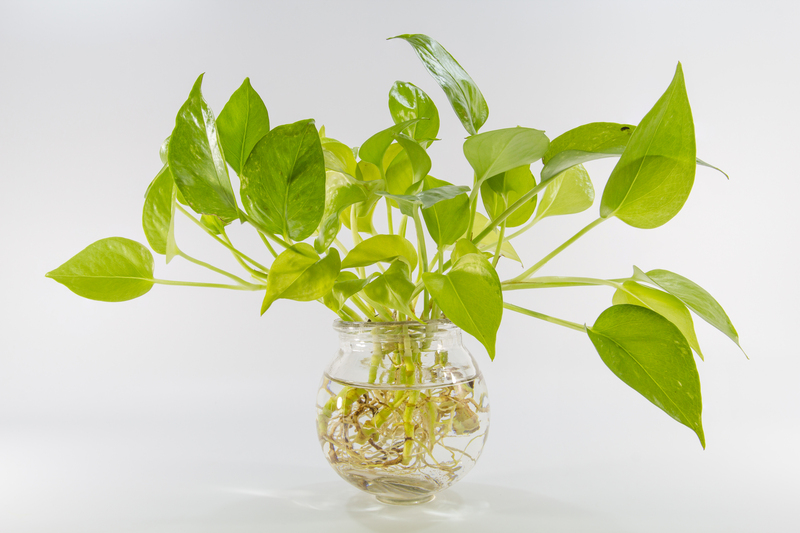Aeration Techniques to Minimize Summer Drought Stress on Your Lawn
Is your lawn struggling to stay green and healthy during the hot, dry months of summer? Discover how proper lawn aeration techniques can dramatically reduce summer drought stress, and help you maintain a lush, vibrant lawn all season long.
Why Summer Drought Stress Harms Lawns
Summer drought can quickly turn a once green and thriving lawn brown and brittle. Drought stress occurs when your grass doesn't get enough water and oxygen, causing the roots to weaken and die back. Issues such as compacted soil, heavy foot traffic, and thick layers of thatch can make things even worse, as they prevent essential water, nutrients, and air from reaching grassroots. That's where lawn aeration becomes your secret weapon for a resilient lawn.

What is Lawn Aeration?
Lawn aeration is the process of perforating the soil--usually by removing small plugs or creating holes--to allow deeper penetration of water, nutrients, and air into the root zone. A well-aerated lawn is better equipped to survive drought by encouraging deeper root growth and improving soil structure. If you're looking to alleviate drought stress on your turf this summer, learning and applying the right aerating methods is a must!
Benefits of Lawn Aeration During Summer
- Improved Water Infiltration: Aeration enables water to soak deeper into the soil, reaching grass roots where it's needed most, reducing runoff and wasted irrigation.
- Stronger, Deeper Roots: Aerated soil promotes deep root growth, making grass more drought-tolerant by reaching moisture reserves unavailable to shallow-rooted lawns.
- Enhanced Nutrient Uptake: Aeration helps fertilizers and nutrients penetrate efficiently, resulting in a greener, hardier lawn even during extended dry spells.
- Prevents Soil Compaction: Alleviating compaction improves grass health and reduces the risk of weeds and diseases that thrive in stressed turf.
- Reduces Thatch Accumulation: Aeration breaks down layers of dead grass and roots (thatch), which can block moisture and exacerbate drought stress.
Types of Lawn Aeration Techniques
Various aerating methods can help relieve summer drought stress, each with its own advantages. The ideal method depends on your soil type, lawn size, and drought conditions.
1. Core Aeration (Plug Aeration)
Core aeration is the most popular and effective technique for minimizing summer drought impact on lawns. It uses a specialized machine or manual tool to remove small cylinders or "cores" of soil and thatch from the ground.
- Why it Works: The holes allow water and nutrients to penetrate compacted soil, stimulating root growth deeper into the soil profile.
- Best For: Lawns with heavy clay soil or significant compaction. Highly recommended in mid-spring or early summer before drought peaks.
- Frequency: Once per year is sufficient for most lawns, but heavily trafficked or compacted yards may need bi-annual aeration.
2. Spike Aeration
Spike aeration involves poking holes in the lawn with spiked shoes, rollers, or manual aerators. Unlike core aeration, spikes push soil aside rather than removing plugs.
- Advantages: Quick, inexpensive, and suitable for small areas or mild compaction.
- Limitations: Holes can close quickly, especially in heavy clay, so water penetration may not last as long as with plug aeration.
- Best For: Routine maintenance on sandy soils or short-term relief during mild droughts.
3. Liquid Aeration
Liquid aeration is an emerging technique using commercial solutions (often based on humic acid) that break apart compacted soil on a microscopic level. Products are applied using a hose-end or tank sprayer.
- Pros: Non-invasive; ideal for large lawns with limited labor. No physical plugs or mess left behind.
- Cons: Not as immediate as mechanical aeration. May need repeated applications, especially in hard soils.
- Best For: Supplementing other aeration methods or enhancing lawns where mechanical aeration isn't feasible.
4. Manual Aeration Tools
For smaller lawns or specific trouble spots, manual aerators like pitchforks, hand corers, or hollow tine tools work well.
- Benefits: Affordable and perfect for spot treatments. Allows targeted relief in high-traffic or persistent dry patches.
- Drawbacks: Labor-intensive for large areas and may not be as thorough as motorized tools.
When is the Best Time to Aerate Your Lawn for Drought Stress?
Timing is crucial to maximize the benefits of aeration during summer. Aerate while the grass is actively growing--but before the highest heat and drought stress set in. For cool-season grasses (fescue, Kentucky bluegrass, rye), aerate in spring or early fall. For warm-season grasses (Bermuda, zoysia, St. Augustine), aerate in late spring to early summer when growth is most vigorous.
Never aerate during a severe drought when grass is dormant, as this can cause more harm than good. The best conditions are when the soil is moist but not soggy. Avoid aerating immediately after heavy rainfalls or watering.
Preparing Your Lawn for Aeration
- Mow your lawn: Reduce grass height to 1.5 to 2.0 inches to make aeration easier and expose the soil.
- Water thoroughly: Moist soil is easier to aerate and yields deeper plug removal. Water one day prior if soil is dry.
- Mark obstacles: Identify irrigation heads, utilities, and any shallow cables with flags or paint to avoid damage.
- Clear debris: Remove leaves, branches, and other debris that may hinder the aeration process.
How to Aerate Your Lawn: Step-by-Step Guide
Step 1: Choose the Right Aeration Tool
Select from a spike, core, or liquid aerator depending on your lawn's needs and your available time and budget.
Step 2: Cover the Entire Lawn Evenly
For core aeration, make at least two passes in different directions for even coverage and ensure plugs are 2-4 inches apart. Overlap slightly for heavy compaction or thatch buildup.
Step 3: Leave Cores on the Lawn
Allow the removed soil plugs to break down naturally. This returns valuable nutrients and organic matter to the soil.
Step 4: Water and Fertilize
After aeration, water deeply to maximize infiltration. Apply a balanced fertilizer to promote root recovery and summer growth. This is an ideal time for overseeding if your lawn is thin or patchy.
Step 5: Monitor and Repeat as Necessary
Repeat the aeration process annually or as your soil conditions require. Monitor for signs of compaction or stressed turf during the growing season.
Supplemental Tips to Minimize Drought Stress After Aeration
- Water deeply and infrequently: Post-aeration, irrigate your lawn to a depth of 6 inches to encourage root development. Early morning is best to reduce losses to evaporation.
- Mulch your clippings: Leave grass clippings in place after mowing to help retain soil moisture and add organic matter.
- Reduce mowing frequency: Let grass grow longer (up to 3 inches) during drought to shade roots and reduce evaporation.
- Avoid nitrogen-heavy fertilizers: Fast growth during drought increases stress. Opt for slow-release or organic fertilizers post-aeration.
- Address thatch build-up: Combine core aeration with dethatching if thatch exceeds 1/2 inch thickness.
- Limit foot traffic: Rest your lawn as much as possible during drought and soon after aeration to promote recovery.
Frequently Asked Questions About Lawn Aeration for Summer Drought
Q1: How do I know my lawn needs aeration?
- Signs include pooling water, hard-packed soil, excessive thatch, patchy or thinning grass, and presence of bare spots even with regular care.
Q2: Can I aerate during a drought?
- Ideally, aerate before severe drought begins. Aerating during peak drought when grass is dormant can hurt recovery and stress roots even further.
Q3: Is core aeration or spike aeration better for clay soils?
- Core (plug) aeration is superior for dense, clay-based soils as it removes compacted layers, while spike aeration may worsen compaction in these areas.
Q4: Should I overseed right after aerating?
- Yes! Aeration opens the soil, providing seed-to-soil contact and enhancing germination, especially in thin or drought-damaged lawns.
Q5: Do I need to fertilize after aerating?
- Applying a balanced fertilizer after aeration helps new roots establish, reducing drought stress. Avoid high-nitrogen products in mid-summer.
Common Mistakes to Avoid When Aerating for Drought Relief
- Not watering beforehand: Aerating bone-dry soil makes it hard for tines to penetrate, and may damage grass roots.
- Using the wrong equipment: Using spike aerators in heavy clay, or not setting machine tines deep enough, limits effectiveness.
- Aerating at the wrong time: Aerating during lawn dormancy or extreme heat can stress grass further instead of helping.
- Ignoring thatch: Not addressing thatch prevents water from fully reaching the root zone, even after aeration.
- Failing to follow up: Improper watering or fertilizing after aeration slows recovery and negates many benefits.

Conclusion: Make Aeration Part of Your Summer Lawn Survival Strategy
Aeration is among the most effective techniques to reduce lawn drought stress in summer. By choosing the right lawn aerating method for your conditions, practicing proper timing, and following up with smart watering and care, you'll enhance your turf's resilience against hot, dry weather. An aerated lawn uses water more efficiently, grows deeper roots, and remains greener, even in the toughest summers.
Don't wait until your grass is brown and brittle--implement these aeration techniques to minimize summer drought stress on your lawn, and enjoy a healthy, beautiful yard all season long.
Related Topics
- Best Watering Practices for Summer Lawns
- How to Dethatch Your Lawn Effectively
- Choosing Drought-Tolerant Grass Varieties
- DIY Lawn Care Tips for Hot Weather
If you found this guide useful, share it with your friends and neighbors, and let's keep our lawns resilient and green through even the hottest, driest months!